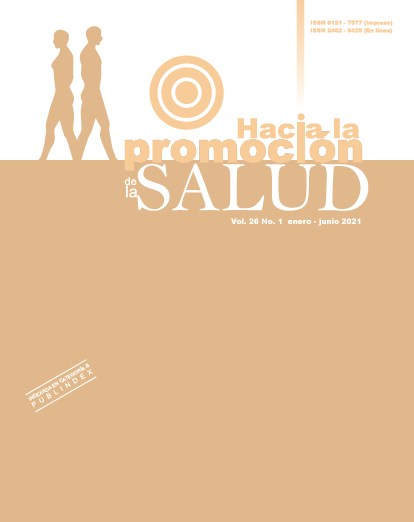Authors
Abstract
Knowledge of the feeding process allows the design of specific programs on food and nutritional security for different social groups, as is the case of indigenous communities that deserve a differential approach. Objective: to understand the experiences of the Curripaco indigenous people settled in the Tierra Alta reservation in relation to the feeding process and the meaning they give to it. Methodology: qualitative study with an ethnographic approach and techniques such as participant observation and semi-structured interviews for collecting information. Results: the following emerging categories were obtained: obtaining food, with the subcategories the conuco, the river or pipe and the jungle; food preparation, which includes the process from the time when the food is obtained to the final dish; special foods, with two subcategories, sacred foods and forbidden foods; and serving the food which includes, among other things, the temperature of the food and the hierarchical order within the family group to serve it. Conclusion: the preservation of ancestral practices related to the feeding process is an important element that has contributed to the conservation of the health of its members over time, so that it is necessary to tend to protect these practices and include them as an essential component of health promotion in the food and nutritional security plans that are developed in the territory.
References
Organización Nacional Indígena Colombiana. Cuáles son y en donde se ubican los pueblos indígenas en Colombia [Internet]. [Consultado 10 nov. 2016]. Disponible en: http://www.onic.org.co/noticias/2-sincategoria/1038-pueblos-indigenas
Gobernación del Guainía. Plan de desarrollo 2016-2019 “un Guainía emprendedor, incluyente y modelo de desarrollo integral”. Guainía; 2016
Ministerio de Cultura. Kurripako, hijos de Inapirriculi [Internet]. Bogotá: Min. Cult.; 2010 [Consultado 10 oct. 2017]. Disponible en http://www.mincultura.gov.co
Mantilla BP, Oviedo MP, Hernández A, Flórez NZ. Educación para la salud: una experiencia con población indígena del departamento de Chocó. Hacia promoc. salud. 2013; 18(2): 96-109. Disponible en: https://www.redalyc.org/articulo.oa?id=309131077008
Bourges H. Costumbres, prácticas y hábitos alimentarios deseables e indeseables. Archivos latinoamericanos de nutrición. 1988; 38(3): 766-779.
Contreras J. Gracia M. Alimentación y cultura. Perspectivas antropológicas. Barcelona: Ariel; 2005
Geertz C. La interpretación de las culturas. Barcelona: Gedisa; 2003
Castillo E. Vásquez ML. El rigor metodológico en la investigación cualitativa. Colombia Médica [Internet]. [Consultado 26 ag. 2017]. Disponible en: http://www.redalyc.org/articulo.oa?id=28334309
Australian Institute of Aboriginal and Torres Strait Islander Studies. Guidelines for Ethical Research in Australian Indigenous Studies. 2a ed. Australia: AIATSIS; 2012
Romero-Moreno ME. Castro-Agudelo LM. Muriel-Bejarano A. Geografía humana de Colombia: región de la Orinoquía tomo III vol. I. Bogotá: Instituto Colombiano de cultura hispánica; 1993
Ministerio del interior y de justicia. Informe final de topografía, ambiental y social del resguardo Curripaco Tierra Alta (Inírida-Guainía). Bogotá; 2010
Carrasco-Henríquez N. Desarrollos de la antropología de la alimentación en América Latina: hacia el estudio de los problemas alimentarios contemporáneos. Estudios sociales (Hermosillo, Son.) [Internet]. 2007 [Consultado 24 abr. 2017]; 15(30): 80-101. Disponible en: http://www.scielo.org.mx/scielo.php?script=sci_arttext&pid=S018845572007000200003&lng=es&tlng=es
Sánchez LF. Caracterización de los grupos humanos rurales de la cuenca hidrográfica del Orinoco en Colombia. Bogotá: Instituto de Investigación de Recursos Biológicos Alexander von Humboldt; 2007
Eraldo M. Costa N. Ramos E. Los insectos comestibles de Brasil: etnicidad, diversidad e importancia en la alimentación [Internet]. [Consultado 24 abr. 2019]. Disponible en: http://sea-entomologia.org/Publicaciones/PDF/BOLN38/423_442BolnSEA38InsectosComestibles
Tapia-Morales C. Améjimínaa majcho: “La comida de nuestra gente”. Etnografía de la alimentación entre los Miraña. Culturales [Internet]. 2009 [Consultado 24 abr. 2019]; (9): 39-72. Disponible en: http://www.redalyc.org/articulo.oa?id=69412153003
Rivas P. Cambio cultural y biodiversidad en las comunidades indígenas de la Orinoquia colombovenezolana: consideraciones sobre el manejo de la fauna. Biota Colombiana [Internet]. 2013 [Consultado el 24 abr. 2019]; 14(1): 109-122. Disponible en: http://www.redalyc.org/articulo.oa?id=49128077008
Woortmann K. Quente, frio e reimoso: alimentos, corpo humano e pessoas. Caderno Espaço Feminino. 2008; 19(1): 17-28.
León-Taborda AM. Formación del cuerpo entre los Tikuna: una aproximación intercultural a los conceptos de nutrición infantil [Internet]. [consultado 24 abr. 2019]. Disponible en: https://revistas.unal.edu.co/index.php/imanimundo/article/view/13963/21330
Levi-Strauss C. El origen de las maneras de mesa. 2a ed. en español. México: Siglo XXI Editores;1976


 PDF (Español)
PDF (Español)
 FLIP
FLIP


























